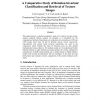Free Online Productivity Tools
i2Speak
i2Symbol
i2OCR
iTex2Img
iWeb2Print
iWeb2Shot
i2Type
iPdf2Split
iPdf2Merge
i2Bopomofo
i2Arabic
i2Style
i2Image
i2PDF
iLatex2Rtf
Sci2ools
BMVC
1998
1998
A Comparative Study of Rotation Invariant Classification and Retrieval of Texture Images
This paper presents a detailed comparative study of 4 rotation invariant texture analysis methods. Human subjects are included as a benchmark for the computational methods. Experiments are conducted on two databases of 450 and 1320 images taken from 10 and 44 Brodatz texture classes respectively. Classification and content based retrieval experiments are used in the comparison, which includes the effect of Gaussian noise on each method (including the human subjects). The methods tested are: the multichannel Gabor filtering method; an edge attribute processing method; the circular simultaneous autoregressive (CSAR) model method and a method based on hidden Markov models with wavelet decomposition. The test conditions in the study are kept both general and constant so direct comparisons of the results obtained can be made.
BMVC 1998 | Brodatz Texture Classes | Computer Vision | Human Subjects | Rotation Invariant Texture |
| Added | 01 Nov 2010 |
| Updated | 01 Nov 2010 |
| Type | Conference |
| Year | 1998 |
| Where | BMVC |
| Authors | Stephanie R. Fountain, Tieniu Tan, Keith D. Baker |
Comments (0)

